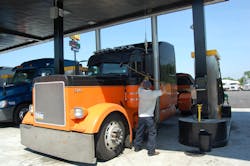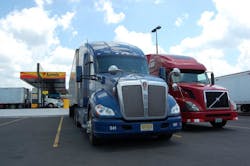Figuring out how to find and retain truck drivers is only going to intensify for most carriers this year, according to experts, with many planning bigger wage boosts to aid in that effort.
In the latest survey issued by Transport Capital Partners (TCP), over 90% of carriers polled by the firm are expecting to increase driver wages this year – with more than a third expecting those wage increases to be in the range of 6% to 10% or double what was reported to TCP six months ago.
"Carriers are seeing potential applicants go to other sectors, like construction, where there is more predictable home time and where extra pay is not limited by federal hours of service (HOS) regulations,” noted Steven Dutro, a TCP partner, in the firm’s report.
“The end result is that revenue from rate increases will go into purchasing new equipment, driver wages, rising maintenance costs, and regulatory costs – and not as much into the carrier’s pockets in 2015," he said.
Yet Eric Starks, president of research firm FTR Transportation Intelligence, that while such pay increase percentages can help alleviate the driver shortage near-term, much higher pay levels may be needed to help foster a longer-term solution to the issue.“We think we’ll need to see really significant pay increases to start attracting real interest from the broader labor force,” he told Fleet Owner. “If we start seeing [driver] pay up around $80,000 per year, then you’ll see far more people willing to make the personal time sacrifices to work that job. At $45,000 to $50,000? Not so much.”
Starks is also unsure how “aggressive” the trucking industry as a whole is prepared to be on the pay issue, which is why he thinks more than a few may opt to focus instead on what he called “margin growth” scenarios.
“If capacity remains tight, instead of expanding operations, many [fleets] may instead focus on increasing rates and their [profit] margins, then share it with their corps of current drivers,” Starks said. “They won’t grow their fleet but they also won’t have to go whole hog on big pay raises either.”
Richard Mikes, a TCP partner, added that carriers as a whole largely remain hesitant to add capacity because of that shortage of experienced drivers, with replacement far outpacing additions on order boards for new tractors.
One option he said carriers are contemplating is pushing for a regulatory change to allow younger drivers under the age of 21 to apply for commercial drivers licenses (CDLs).
Mikes noted that, according to TCP’s current survey, that “younger driver” concept enjoys large support in the industry, with 84% of carriers in the firm’s poll in favor of it. Support is similar between large and small carriers, despite smaller carriers typically hiring fewer inexperienced drivers, he added.
Yet although over 80% of the industry supports hiring younger drivers, the percentage of carriers actually hiring inexperienced drivers is only at 33%, Mikes stressed.
“It is likely that the shift to hiring more inexperienced drivers will continue, albeit slowly, [with] 64% of carriers surveyed indicated they would be interested in hiring less experienced drivers,” he added. “Larger companies are twice as likely to hire inexperienced drivers as smaller companies, perhaps because they have the staff and resources to invest in training facilities and co-drivers.”
About the Author
Sean Kilcarr
Editor in Chief
Sean Kilcarr is a former longtime FleetOwner senior editor who wrote for the publication from 2000 to 2018. He served as editor-in-chief from 2017 to 2018.

